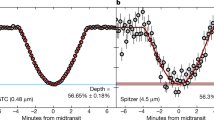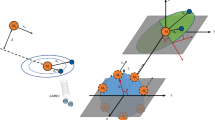Abstract
The ‘hot Jupiters’ that abound in lists of known extrasolar planets are thought to have formed far from their host stars, but migrate inwards through interactions with the proto-planetary disk from which they were born1,2, or by an alternative mechanism such as planet–planet scattering3. The hot Jupiters closest to their parent stars, at orbital distances of only ∼0.02 astronomical units, have strong tidal interactions4,5, and systems such as OGLE-TR-56 have been suggested as tests of tidal dissipation theory6,7. Here we report the discovery of planet WASP-18b with an orbital period of 0.94 days and a mass of ten Jupiter masses (10 MJup), resulting in a tidal interaction an order of magnitude stronger than that of planet OGLE-TR-56b. Under the assumption that the tidal-dissipation parameter Q of the host star is of the order of 106, as measured for Solar System bodies and binary stars and as often applied to extrasolar planets, WASP-18b will be spiralling inwards on a timescale less than a thousandth that of the lifetime of its host star. Therefore either WASP-18 is in a rare, exceptionally short-lived state, or the tidal dissipation in this system (and possibly other hot-Jupiter systems) must be much weaker than in the Solar System.


Similar content being viewed by others
References
Lin, D. N. C., Bodenheimer, P. & Richardson, D. C. Orbital migration of the planetary companion of 51 Pegasi to its present location. Nature 380, 606–607 (1996)
Tanaka, H., Takeuchi, T. & Ward, W. R. Three-dimensional interaction between a planet and an isothermal gaseous disk. I. Corotation and Lindblad torques and planet migration. Astrophys. J. 565, 1257–1274 (2002)
Rasio, F. & Ford, E. B. Dynamical instabilities and the formation of extrasolar planetary systems. Science 274, 954–956 (1996)
Hut, P. Tidal evolution in close binary systems. Astron. Astrophys. 99, 126–140 (1981)
Eggleton, P. P., Kiseleva, L. G. & Hut, P. The equilibrium tide model for tidal friction. Astrophys. J. 499, 853–870 (1998)
Sasselov, D. D. The new transiting planet OGLE-TR-56b: orbit and atmosphere. Astrophys. J. 596, 1327–1331 (2003)
Ogilvie, G. I. & Lin, D. N. C. Tidal dissipation in rotating solar-type stars. Astrophys. J. 661, 1180–1191 (2007)
Pollacco, D. L. et al. The WASP project and the SuperWASP cameras. Publ. Astron. Soc. Pacif. 118, 1407–1418 (2006)
Sahu, K. C. et al. Transiting extrasolar planetary candidates in the Galactic bulge. Nature 443, 534–540 (2006)
Pont, F. et al. A transiting planet among 23 new near-threshold candidates from the OGLE survey—OGLE-TR-182. Astron. Astrophys. 487, 749–754 (2008)
Baraffe, I., Chabrier, G., Allard, F. & Hauschildt, P. H. Evolutionary models for solar metallicity low-mass stars: mass-magnitude relationships and color-magnitude diagrams. Astron. Astrophys. 337, 403–412 (1998)
Hebb, L. et al. WASP-12b: The hottest transiting planet yet discovered. Astrophys. J. 693, 1920–1928 (2009)
Boesgaard, A. M. & Tripicco, M. J. Lithium in the Hyades cluster. Astrophys. J. 302, L49–L53 (1986)
Dobbs-Dixon, I., Lin, D. N. C. & Mardling, R. A. Spin–orbit evolution of short-period planets. Astrophys. J. 610, 464–476 (2004)
Meibom, S. & Mathieu, R. D. A robust measure of tidal circularization in coeval binary populations: the solar-type spectroscopic binary population in the open cluster M35. Astrophys. J. 620, 970–983 (2005)
Goldreich, P. & Soter, S. Q in the Solar System. Icarus 5, 375–389 (1966)
Peale, S. J. Origin and evolution of the natural satellites. Annu. Rev. Astron. Astrophys. 37, 533–602 (1999)
Levrard, B., Winisdoerffer, C. & Chabrier, G. Falling transiting extrasolar giant planets. Astrophys. J. 692, L9–L13 (2009)
Jackson, B., Greenberg, R. & Barnes, R. Tidal heating of extrasolar planets. Astrophys. J. 681, 1631–1638 (2008)
Laughlin, G. et al. Rapid heating of the atmosphere of an extrasolar planet. Nature 457, 562–564 (2009)
Pätzold, M. & Rauer, H. Where are the massive close-in extrasolar planets? Astrophys. J. 568, L117–L120 (2002)
Pätzold, M., Carone, L. & Rauer, H. Tidal interactions of close-in extrasolar planets: The OGLE cases. Astron. Astrophys. 427, 1075–1080 (2004)
Gillon, M. et al. Improved parameters for the transiting hot Jupiters WASP-4b and WASP-5b. Astron. Astrophys. 496, 259–267 (2009)
Israelian, G., Santos, N. C., Mayor, M. & Rebolo, R. Evidence for planet engulfment by the star HD 82943. Nature 411, 163–166 (2001)
van Leeuwen, F. Validation of the new Hipparcos reduction. Astron. Astrophys. 474, 653–664 (2007)
Collier-Cameron, A. et al. WASP-1b and WASP-2b: two new transiting exoplanets detected with SuperWASP and SOPHIE. Mon. Not. R. Astron. Soc. 375, 951–957 (2007)
West, R. et al. The low density transiting exoplanet WASP-15b. Astron. J. 137, 4834–4836 (2009)
Acknowledgements
We thank the South African Astronomical Observatory for hosting WASP-South and the UK’s Science and Technology Facilities Council for funding.
Author Contributions WASP-S construction, operation and candidate selection (C.H., D.R.A., D.M.W., P.F.L.M., B.S., S.J.B.); WASP-S design (D.L.P); WASP observatory software (J.I., D.R.A., P.F.L.M.); WASP-S data processing (D.R.A., D.M.W., B.S.); WASP data pipeline (A.C.C., T.A.L., N.P., K.H.); transit-search code (A.C.C., L.H., B.E.); WASP data archive (R.G.W., P.J.W.); Coralie/EulerCAM data (M.G., A.H.M.J.T., D.S., D.Q.); Euler/Coralie construction and upgrade (D.Q., M.M., S.U., F.P.); planet characterization (A.C.C., D.R.A., M.G.); host star characterization (B.S., L.H.); paper writing (C.H., A.C.C.).
Author information
Authors and Affiliations
Corresponding author
Supplementary information
Supplementary Information
This file contains Supplementary Table 1 and Supplementary Figures 1-4 with Legends. (PDF 259 kb)
PowerPoint slides
Rights and permissions
About this article
Cite this article
Hellier, C., Anderson, D., Cameron, A. et al. An orbital period of 0.94 days for the hot-Jupiter planet WASP-18b. Nature 460, 1098–1100 (2009). https://doi.org/10.1038/nature08245
Received:
Accepted:
Issue Date:
DOI: https://doi.org/10.1038/nature08245
- Springer Nature Limited
This article is cited by
-
An infrared transient from a star engulfing a planet
Nature (2023)
-
A broadband thermal emission spectrum of the ultra-hot Jupiter WASP-18b
Nature (2023)
-
The contribution of the major planet search surveys to EChO target selection
Experimental Astronomy (2015)
-
Searching for a gas cloud surrounding the WASP-18 planetary system
Astrophysics and Space Science (2014)
-
A new class of planet
Nature (2012)





